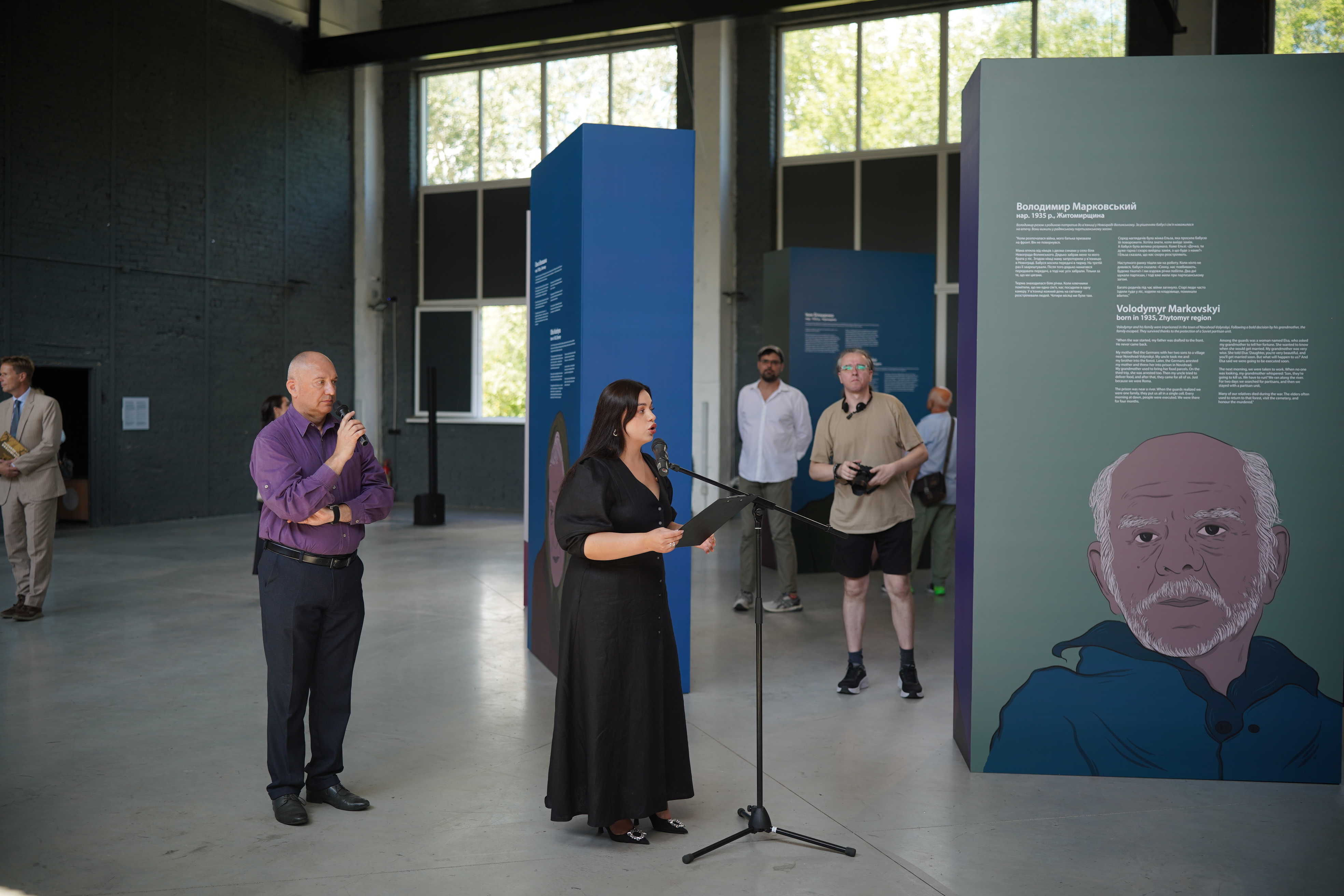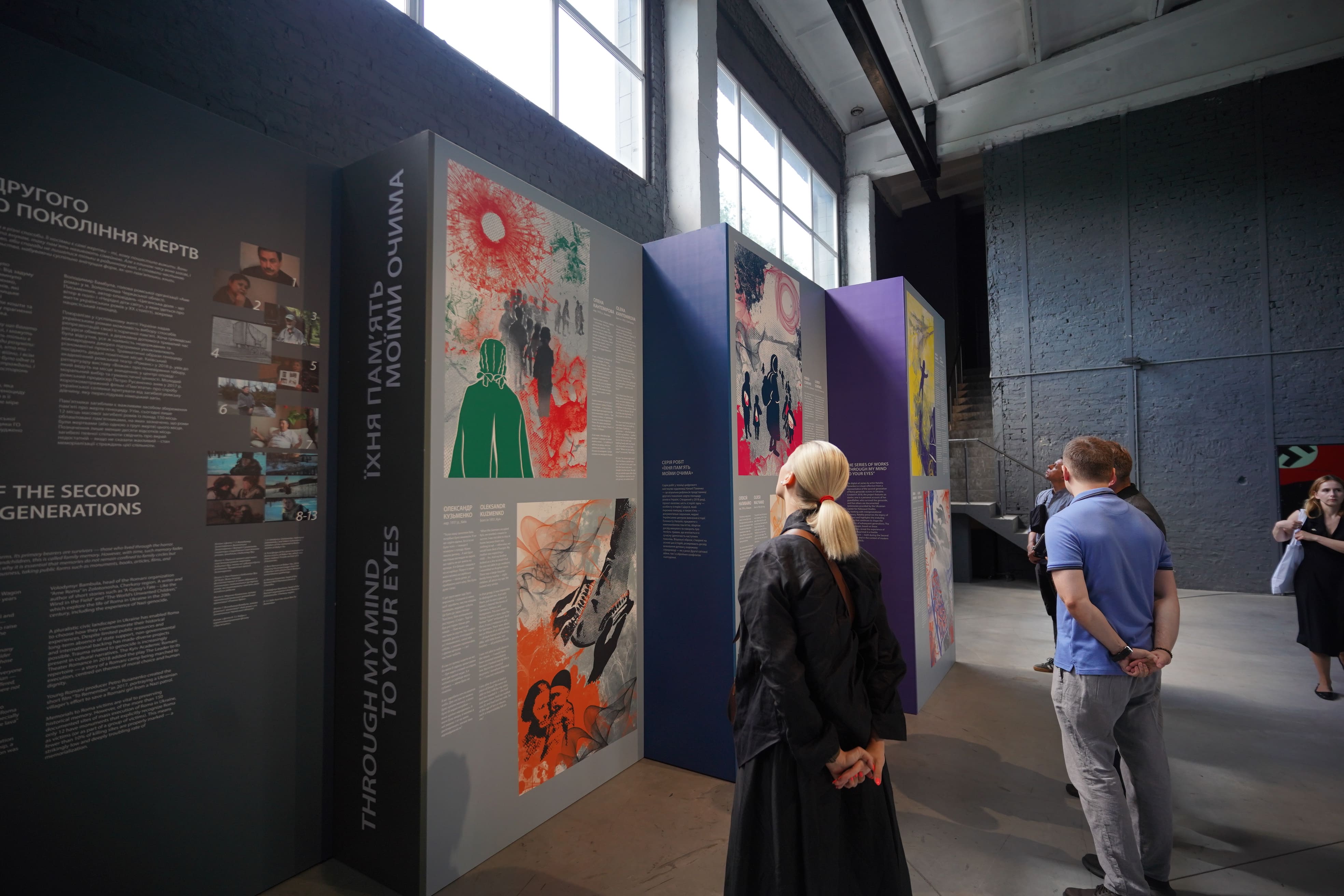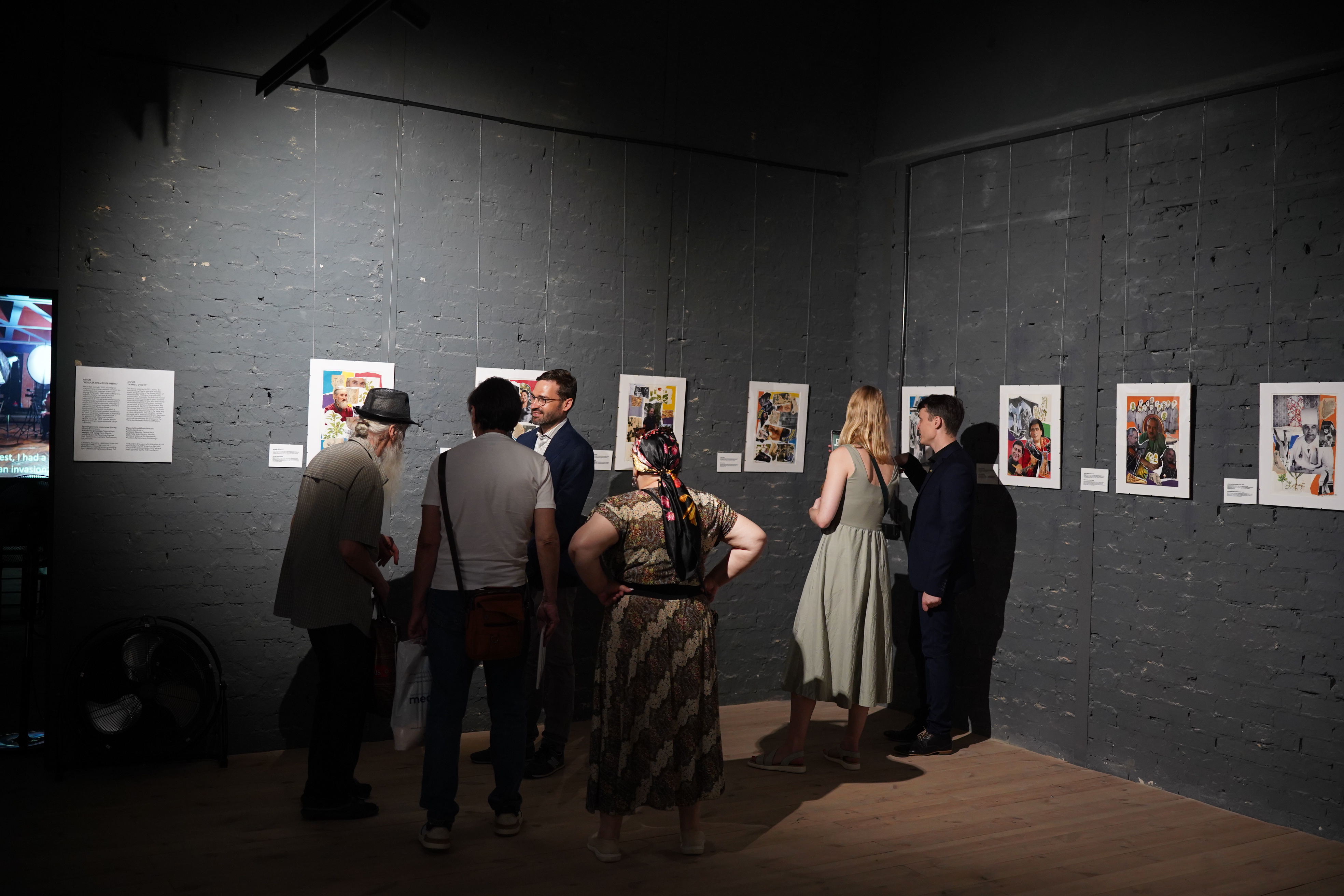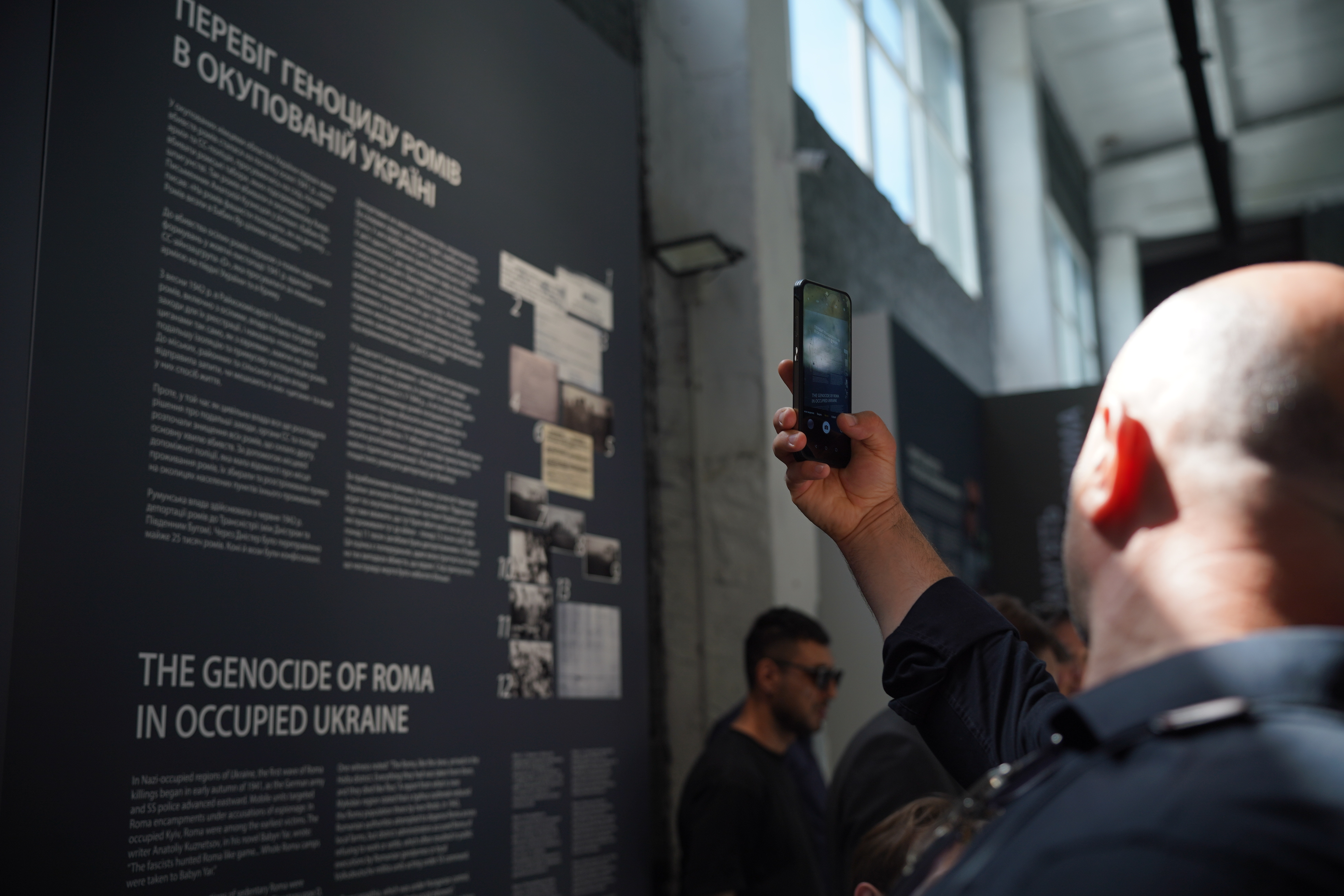“Invisible. Resilience: The Past and Present of the Roma”: An exhibition about the Roma has opened
On August 2, 2025, the International Roma Genocide Remembrance Day, the exhibition The Invisible. Resilience: Past and Present of the Roma opened at the "Living Memory" exhibition center of the Babyn Yar National Historical and Memorial Preserve. This thematic-narrative project brings attention back to those who remained invisible to society for far too long.
The exhibition tells the story of Roma identity as a form of resistance — from Nazi persecution and genocide during World War II to contemporary civic leadership and the participation of roma in Ukraine’s defense.
"Among the victims of Babyn Yar were Roma families — men, women, and children. Their names have not been preserved, but their lives and their tragedy are a part of historical truth that we must remember and voice. The Babyn Yar National Preserve, as an institution, aims to preserve this memory and support the Roma community in its pursuit of being heard," said Roza Tapanova, Director of the Babyn Yar National Historical and Memorial Preserve, in her opening remarks.
Three content-rich sections of the exhibition present the past, the present, and the artistic interpretation of Roma history. Archival documents, testimonies, contemporary art, and portraits of Roma soldiers, activists, and artists together create a coherent and emotionally precise narrative.
"August 2 is not only about the past. It is a day of responsibility — for memory, for dignity, and for the right to be heard. Roma history is a part of Ukrainian history," said Nataliia Tomenko, the lead curator of the exhibition and representative of the Youth Agency for the Advocacy of Roma Culture “ARCA.”

Mykhailo Tyahlyi, a researcher at the Ukrainian Center for Holocaust Studies, emphasized: "Historically, Roma voices have been invisible. But exhibitions like this one allow them to be heard fully and with dignity — as part of the national narrative of Ukraine."
"This exhibition not only reminds us of the tragedies of the past, but also bears witness to the strength, resistance, and cultural resilience of Roma communities. Through the personal stories of those who survived persecution, we see the ongoing Roma struggle for dignity and equal rights. The memory of these crimes is an important element of Ukraine's European path and shared democratic values. That is why we must speak out decisively against racism, antigypsyism, and any form of discrimination," said Maximilian Rasch, Chargé d'Affaires of the German Embassy, a partner of the exhibition.
Oleksandr Alfiorov, Head of the Ukrainian Institute of National Remembrance, noted:
"They were Ukrainian citizens of Roma origin who became victims of genocide between two totalitarian regimes. We remember each one — because these tragedies shape our shared understanding of history."
The exhibition was created by the Youth Agency for the Advocacy of Roma Culture “ARCA” in partnership with the Babyn Yar National Historical and Memorial Preserve and the Ukrainian Center for Holocaust Studies. The project was supported by the Embassy of Germany in Ukraine and the Ukrainian Institute of National Remembrance. Informational support was provided by the Ukrainian Roma Advocacy Alliance “AURA.”

Curators: Nataliia Tomenko, Chinara Majidova, Volodymyr Yakovenko
Historical Consultant: Mykhailo Tyahlyi
Address: "Living Memory" Exhibition Center, 46A Yuri Illienko St.
Exhibition dates: August 2 – September 7, 2025
Opening hours:
Mon–Fri: 10:00–19:00
Sat–Sun: 11:00–18:00
Admission: Free
REFERENCE:
“It's easy to tell, but hard to live through.”
— Raisa Andriichenko, romni, Roma genocide survivor, Ukraine
The Invisible. Resilience: Past and Present of the Roma is a thematic-narrative exhibition about the return of visibility. Once muted, Roma voices now sound boldly, clearly, and with a claim to equality. At the heart of the exhibition is Roma identity as a form of resistance traced throughout history: from persecution during the Roma genocide in World War II to the strength, visibility, and civic activism of Roma communities in Ukraine today, in the ongoing struggle for justice in the Russian-Ukrainian war. Through the testimonies of Roma genocide survivors, archival materials, and contemporary art media, the exhibition shows the transformation of silence into voice, trauma into strength, and invisibility into presence. These are not only stories of survival in the past — they are stories about shaping the future.

ABOUT THE EXHIBITION
The exhibition begins with a historical foundation: documentary evidence of the genocide of the Roma in Ukraine during World War II. Archival photographs, documents, and recorded testimonies from survivors reveal a little-known and suppressed chapter of history. Personal stories, video testimonies, and illustrations allow Roma survivors to speak directly to the viewer. These materials not only document the systemic violence and displacement suffered by Roma communities, but also highlight the emotional and cultural wounds left by the genocide. This living, witnessed memory forms the foundation of the exhibition and is the main means of restoring dignity and recognition to those who were made invisible.
The exhibition features perspectives from contemporary Roma artists — members of the second and third generations of Roma who survived the genocide during World War II. They reflect on intergenerational trauma and the consequences of erased identity. The digital works of Nataliia Tomenko are deeply personal visual reflections on themes of fear, survival, and resilience. She not only documents but brings the viewer into a psychological and emotional space of memory, building a bridge between past and present. Alongside an animated short film, these works allow audiences to experience a living heritage that shapes modern Roma identity and a sense of belonging.

The final section of the exhibition turns to the present. Ukrainian artist Oleksandr Maksymov presents a series of dynamic collages portraying current Roma soldiers in the Armed Forces of Ukraine, as well as cultural and civic figures. These works emphasize the ongoing struggle for dignity, visibility, and inclusion of roma in Ukrainian public life. Against the backdrop of the Russian-Ukrainian war, Maksymov’s collage-portraits honor Roma citizens who resist marginalization, actively participate in civic life, and defend justice. The final section connects the resilience of the past with the energy of the contemporary Roma movement, emphasizing that Roma history is not only a story of suffering, but also one of strength, continuity, and the creation of the future.
ABOUT AUGUST 2
August 2 – International Roma Genocide Remembrance Day: the history of the date and its current commemoration
On August 2, the world honors the victims of the Roma genocide during World War II. This date is linked to the tragic events of the night of August 2–3, 1944, when the so-called "Gypsy Camp" (Zigeunerlager) at Auschwitz-Birkenau was liquidated. In one night, the Nazis murdered about 2,900 Roma and Sinti — mostly women, children, and the elderly. Their bodies were burned in crematoria. This event became a symbol of the mass extermination of the Roma people during the war.
Overall, the Nazi policy of annihilation claimed the lives of between 220,000 and 500,000 Roma across Europe. In Ukraine, mass shootings of roma took place in many cities and villages during the occupation, including at Babyn Yar in Kyiv.
From the outset, Nazi ideology viewed roma as a "dangerous" and "inferior" group. The first deportations of roma to special camps began as early as 1935, and from 1940 became widespread. At the time, roma in Ukraine led both nomadic and settled lifestyles, but that made no difference — persecution and killings affected everyone. More than 140 mass executions of roma are known to have occurred in Ukraine.
For a long time after the war, the history of this tragedy remained invisible. A false belief spread that roma were exterminated not because of racial policy, but supposedly because of "antisocial behavior." Only in 1982 did the government of the Federal Republic of Germany officially recognize the persecution of roma during World War II as an act of racism. In 2015, the European Parliament established August 2 as the official International Roma Genocide Remembrance Day.
Every year on this day, commemorative events take place in Poland, Germany, the Czech Republic, Slovakia, Hungary, Romania, and other European countries. The central ceremony is held at the Auschwitz-Birkenau Memorial with the participation of Roma and Sinti organizations, government representatives, and international institutions. In various countries, people also lay flowers at mass execution sites, and host exhibitions, lectures, discussions, and youth memory camps (Dikh He Na Bister). The goal of these events is to make the Roma tragedy a visible part of European historical memory.
In Ukraine, the symbolic place of remembrance is the "Roma Wagon" memorial at Babyn Yar. It commemorates the thousands of roma killed by the Nazis during the occupation of Kyiv. The idea for the memorial arose in the 1990s from Volodymyr Zolotarenko, head of the Kyiv Roma Society, but it was only implemented in 2016 by his son Artur. The wagon, a traditional symbol of nomadic life, serves as a reminder of the path of the Roma people — a path the Nazis tried to destroy.
The commemorative events on August 2 are important not only for the Roma community but for society as a whole. They restore the memory of crimes that were long silenced and remind us of the dangers of discrimination and xenophobia. These events highlight that Roma history is part of the shared history of the peoples of Europe.
Today, roma along with other citizens of Ukraine are defending the country against Russian aggression: serving in the Armed Forces, volunteering, helping internally displaced people, and rebuilding communities. Like many others, they have endured occupation, the loss of homes, injuries, captivity, and separation from families. Commemorating the victims of past crimes is a reminder that such tragedies must never happen again.
Reference prepared by Youth Agency for the Advocacy of Roma Culture “ARCA” and Babyn Yar National Historical and Memorial Preserve
Photographer: Ruslan Syngaiievskyi
See also
- У межах виставки «Невидимі. Стійкість: минуле і сучасність ромів» відбулися кураторські екскурсії, я
- Curator's tour as part of the exhibition “The Invisible. Resilience: The Past and Present of the Rom
- «Me — Ukrayinatar». An exhibition of collages authored by a Ukrainian painter was presented in Germa
- To see, to feel, to remember: A new exhibition was unveiled in the Babyn Yar Museum
- Winners of the Roma Artists Support Program from Ukraine
- Me Ukrainatar exhibition in Drohobych
- “ARCA" opens Me Ukrainatar exhibition in Ivano-Frankivsk
- Performance Named Voices in Krakow
- Documentary performance "From Home to Home"